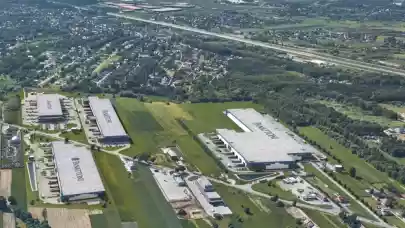
Despite many negative factors, Q4 2022 showed that the economy in Slovakia should grow by 1.8% in 2022. Energy prices were stabilized, inflation peaked and we could see the increase in yields. The Slovak industrial sector remained once more the most resilient real estate segment and experienced very solid performance in 2022. In the same period, the lack of new supply resulted in lowered vacancies in offices. Overall retail park projects dominate both this year’s new supply and future retail development with limited space for larger retail schemes due to high saturation. Cushman & Wakefield published its market reports for Q4 2022.
A solid rebound of the local economy after the elimination of pandemic restrictions in 2022 was slowed down by an increase in energy prices connected with the conflict in Ukraine. Despite many negative factors, the last quarter showed that the economy is more resilient than predicted and the economy should grow by 1.8% in 2022. Energy prices have stabilized, and the sales of firms continue to rise although increasing costs are impacting many tenants, especially from the retail sector who have already struggled before. Furthermore, rising input costs and weakening global demand are behind pessimism in the corporate sector. Although inflation reached a record high level of 12.8% in 2022, its growth has already peaked in both the Eurozone and Slovakia, indicating a progressive decline in 2023. To further tame inflation, European Central Bank hiked interest rates to 2.5% in December. Additionally, the Slovak government's measures to cap energy prices for businesses and households should also contribute to reducing inflation and positively impacting purchasing power that would be otherwise impacted heavily by rising costs. Nonetheless, the labour market remains resilient and unemployment keeps fallen to 5.9% as of December.
Industrial market
The Slovak industrial sector remained the most resilient real estate segment and experienced very solid performance in 2022. Its rapid growth continued in Q4 as 9 new buildings together with 108,500 sqm hit the completed status whilst 85 % of that area was already pre-leased. 2022’s new supply figures stand at a record-breaking 435,800 sqm with pre-leased space at the time of completion at 80 %. Healthy supply levels go side by side with unceasing demand which also persisted in Q4. Gross take-up represented 156,000 sqm and net take-up 102,600 sqm. Nevertheless, the vacancy rate remains low at 3.6% and while the market remains landlord orientated for now, we expect some sort of alignment between landlords and tenants to come in 2023. Partly as a result of solid take-up in the last quarter, we witnessed the highest gross (792,200 sqm) and net (643,500 sqm) yearly take-up. In comparison to the last five year’s averages, gross take-up reached a substantial 84% increase whereas net take-up almost doubled its size. This year’s demand was driven, as in previous years, predominately by automotive, 3PL and e-commerce (although e-commerce started cooling off in the second half of the year). On the other hand, speculative development is offset by built-to-suit projects rendered by tight project financing conditions, high inflation, and the uncertainty surrounding the economy in the upcoming year. Consequently, industrial space under construction in Q4 shrinks to 261,400 with only one-third pre-leased.
Rents remained under upward pressure caused by persisting elevated inflation, input and energy costs. Accordingly, headline rents in all submarkets rose by at least 20-30 cents/sqm notably in Trenčin and East Slovakia, as well as prime rent, which hit €4.40/sqm/month and we expect its progressive growth in H1 2023. Concerning financing and other factors, we saw an increase in prime yield by 25 bps to 5.50% reflecting the overall shift of the cycle in 2022. Although further growth will go side by side with other real estate segments, rising yields are partially offset by the high indexation of rents and the increase in market rents, especially in the industrial sector. Therefore, landlords prefer longer rental contracts. In 2022 we saw an increased amount of landbanks transactions by industrial developers, especially in the Bratislava region, as a preparation for the future development cycle.
Office market
Restored demand from the previous quarter continued in Q4 as gross take-up reached 54,500 sqm and net take-up 25,500 sqm. In 2022 total gross and net take-up reached levels of 163,800 sqm and 118,900 sqm respectively. However, both figures still ended slightly below the average of the last 5 years, underlining the growing tension in the market. Completion of NIDO2 was postponed to the next quarter, therefore only 2 buildings were delivered to the office market this year – Omnia BC in Q1 with an area of 11,160 sqm and Lake Side 02 in Q3 with 14,000 sqm. Despite the lower take-up in 2022, the lack of new supply resulted in a mild decline in the vacancy rate in almost all submarkets, to 11.2%. However, last year’s absence of new supply will be offset by 4 major projects, which should be completed in 2023 and bring 113,300 sqm of A+ office spaces. Consequently, we expect vacancies to grow gradually throughout the year, partly as a result of a lower pre-leased status of future projects followed by the downsizing of many of the existing tenants at renegotiation. On the other hand, companies which are either expanding, hiring employees or both are still visible on the market and the public sector should continue to play a major role on the demand side.
Due to the increasing energy prices and high inflation, there is pressure on landlords to increase service charges by 30-50% which is offsetting any potential increase in rents that might otherwise materialize. Mild rent increase remains a domain of only the best projects on the market with high energy efficiency and high appeal for tenants. While new developments seem to be unfeasible at currently achievable market rents in less attractive locations we do not expect any rent increase unless the current vacancy is leased or at least decreased significantly. Despite an increase in service charges, asking rents remained unchanged in all submarkets. Prime rent also remained intact at €17/sqm/month and should persist in Q1 2023 as nothing indicates otherwise. However, most landlords are currently facing the decision of whether to increase headline rents while increasing fit-out contributions, or keep headline rents at current levels and struggle to cover costs due to insufficient fit-out contributions. Rising financing costs have increased prime yield by 50 bps to 5.50% and additional growth is expected in the following quarters. Rising yields are partially offset by the high indexation of rents and the increase in market rents.
Retail market
Overall retail park projects dominate both this year’s new supply and future retail development with limited space for larger retail schemes due to high saturation. In the fourth quarter, we saw several completions - one shopping centre Siko in Košice, brand new retail parks in Nitra, Kysucké Nové Mesto and Zvolen as well as 2 extensions of existing retail parks in Trnava and Zvolen. Thus, more than 34,000 sqm of retail space was added to stock in Q4 and 2022’s new supply accumulated to 66,700 sqm. Higher saturation, mostly in regional cities, is shifting developers‘ focus from shopping centres to retail parks, in particular to less saturated (mostly smaller) cities. It is backed by future development figures as the total retail area, which has planned delivery latest by the end of 2024, amounted to 127,000 sqm and consists mainly of retail parks – 13 out of 18 buildings. Vacancy in prime schemes in Bratislava and around Slovakia stands below 5%. On the other hand, less-performing schemes are more and more vacant, deepening a gap between prime and non-prime retail establishments. Furthermore, retail operations that depend mostly on office footfall continue to struggle.
Overall turnovers, footfall and consumer sentiment remained more or less unchanged this year and also in the last quarter compared to an average of pre-covid years even despite the conflict in Ukraine. Although energy prices increased substantially and therefore overall rents rose, only a minority of retailers were forced to close in 2022, mainly in the food & beverages sector. However, rising service charges in combination with lower purchasing power caused by inflation should impact retailers in the year to come. Prime rents remained unchanged throughout the whole year for both shopping centres and retail parks at €65/sqm/month and €9.5/sqm/month respectively. Rising financing costs have increased yields in prime shopping centres to 6.25% for prime shopping centres whereas stayed unchanged for well-established retail parks at 7.00%. Although rising yields are partially offset by the high indexation of rents and the increase in market rents, further growth of yields is expected.



